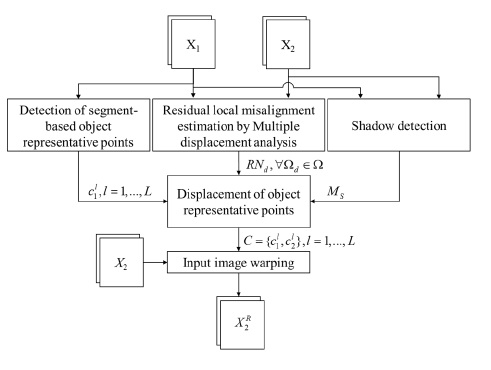- ALL COMPUTER, ELECTRONICS AND MECHANICAL COURSES AVAILABLE…. PROJECT GUIDANCE SINCE 2004. FOR FURTHER DETAILS CALL 9443117328


Projects > ELECTRONICS > 2017 > IEEE > DIGITAL IMAGE PROCESSING
In this paper, a segmentation-based approach to fine registration of multispectral and multitemporal very high resolution (VHR) images is proposed. The proposed approach aims at estimating and correcting the residual local misalignment that often affects multitemporal VHR images even after standard registration. The method extracts automatically a set of object representative points associated with regions with homogeneous spectral properties (i.e., objects in the scene). Such points result to be distributed all over the considered scene and account for the high spatial correlation of pixels in VHR images. Then, it estimates the amount and direction of residual local misalignment for each object representative point by exploiting residual local misalignment properties in a multiple displacement analysis framework. To this end, a multiscale differential analysis of the multispectral difference image is employed for modeling the statistical distribution of pixels affected by residual misalignment (i.e., RN pixels) and detect them. The RN is used to perform a segmentation-based fine registration based on both temporal and spatial correlation. Accordingly, the method is particularly suitable to be used for images with a large number of border regions like VHR images of urban scenes.
Scale-Invariant Feature Transform (SIFT), Wavelet-Based Image Registration Technique, Interest-Point-Matching Algorithm.
The proposed approach provides three main contributions: 1) fine registration is carried out for accurate and precise geometric alignment using multitemporal correlation throughout the RN concept; 2) the proposed mechanism accounts for the spatial correlation among neighboring pixels and the complex geometry of VHR images by use of segments. Thus pixels belonging to the same object are treated in a homogeneous way when warping is applied; and 3) object representative points for estimating/applying the warping function are distributed all over the scene allowing for an effective correction of local misalignments. Thus, the fine registration produces accurate performance at local level all over the considered scene. In this paper, we proposed an approach to fine registration of multitemporal images that aim at correcting local residual misalignments after standard registration. The method defines a set of object representative points that accounts for the spatial correlation and the spectral homogeneity of pixels in the reference image. This choice results in distributed object representative points and allows for an accurate chasing of the local behaviors of residual misalignment. The displacement of object representative points is established by a multiple displacement analysis of residual local misalignment. The quality of object representative points is improved by employing shadow information. Both qualitative and quantitative experimental results demonstrated that the proposed approach is able to improve the registration accuracy with respect to the literature registration approaches if residual misalignment exists. Although the approach is general and can be applied to any kind of multitemporal images, it becomes particularly suitable for those scenes that show a large number of objects (and thus borders) where standard methods tend to generate larger local distortions. This is the case with VHR multitemporal images acquired over urban areas, but also with medium resolution images that contain sharp edges. On the contrary, scenes with a small number of objects (and thus borders) suffer less from local misalignments after registration and thus the registration improvement by the proposed method is smaller.
SEGMENTATION NETWORK
